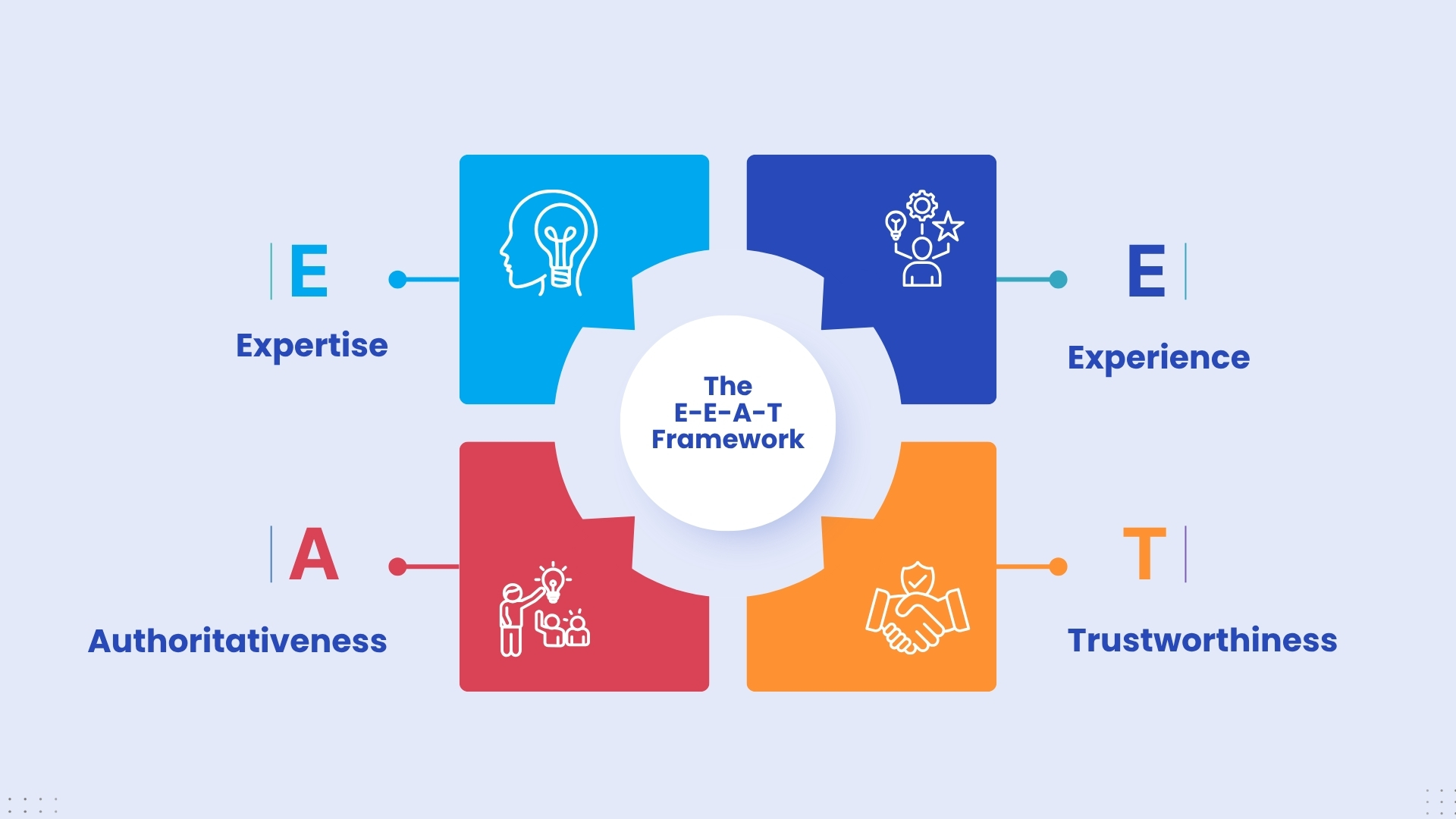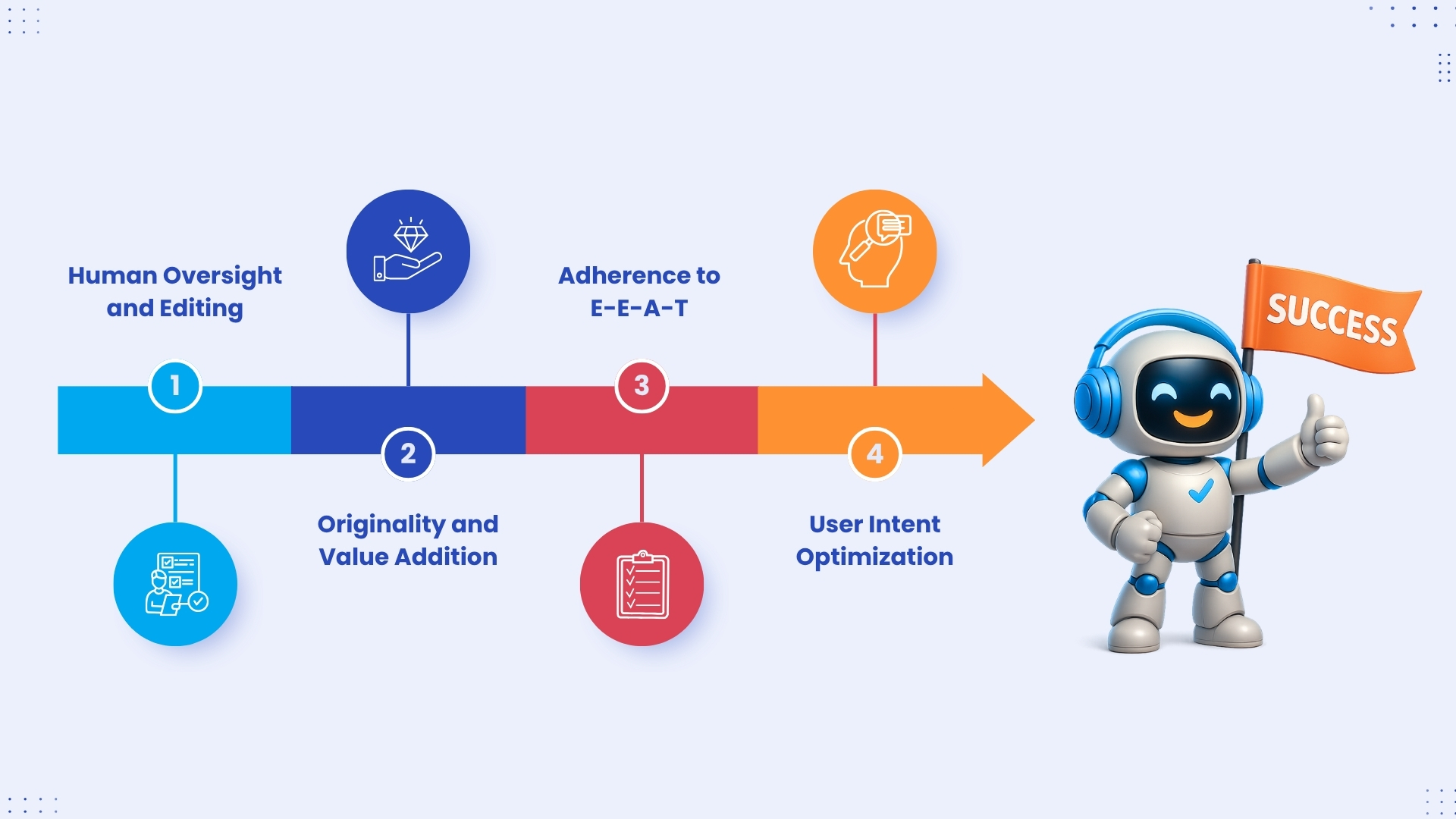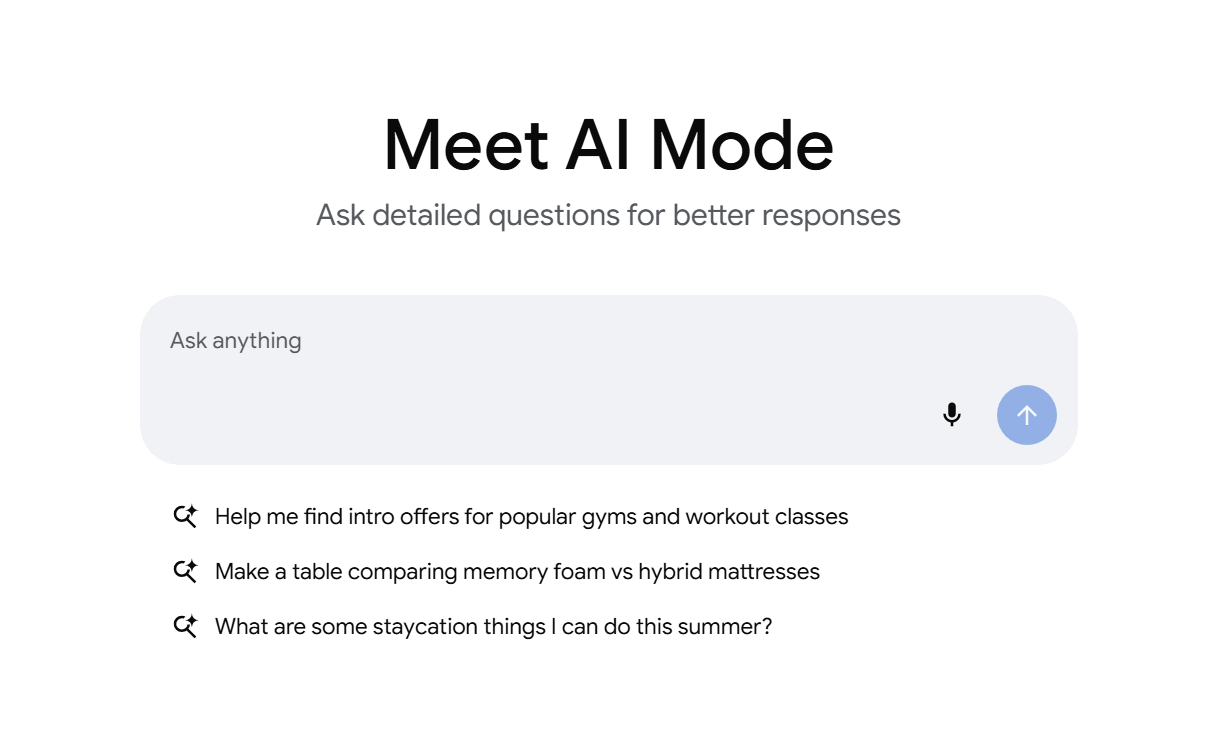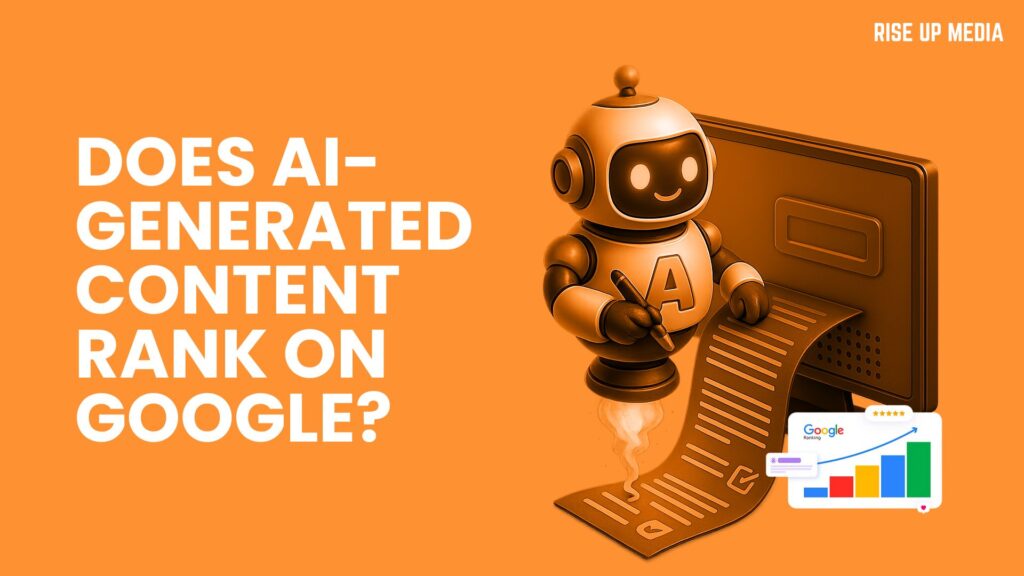Marketers have been on a mission to implement as much AI into their marketing processes as possible to increase efficiencies and performance.
However, most (especially SEO-conscious) marketers are worried that AI-generated (or AI-assisted) content they’re creating won’t appear in search engines like Google, GPT Search, and Perplexity.
Read on to find out whether your AI-assisted content will rank or not.
TL;DR
The definitive answer is that AI-generated content can rank on Google and appear prominently within its AI Search results, including AI Overviews and AI Mode.
Google’s overarching principle is that content quality, rather than its creation method, determines its ranking potential.
Content that demonstrates Expertise, Experience, Authoritativeness, and Trustworthiness (E-E-A-T) and is genuinely helpful to users stands the best chance of visibility.
Empirical studies indicate that AI-assisted content (refined with human oversight!) can perform comparably to human-written content, often leading to increased organic traffic.
However, there’s a crucial caveat: unedited, low-quality, or mass-produced AI content that lacks originality or factual accuracy is highly susceptible to penalties under Google’s stringent spam policies.
Success in the new search landscape necessitates a “human-in-the-loop” approach, where AI serves as a powerful tool for efficiency and scale, augmented by expert human oversight to ensure quality, accuracy, and the infusion of unique, people-first value.
The Changing Landscape of AI and Google Search
Artificial Intelligence is reshaping Search Engine Optimization (SEO) as we know it and the very nature of Google’s search functionalities.
Google has deeply integrated AI into its core algorithms and is now moving beyond rudimentary keyword matching to a sophisticated understanding of user intent. Users receive increasingly personalized search results as interaction with search engines becomes more conversational and direct.
Content creators must now adapt their strategies to align with current Google algorithms, recognizing that AI is increasingly becoming the primary interface through which users consume information.
A critical question, thus, emerges for content creators and marketers: Does content generated with AI tools successfully rank in traditional Google Search results, and how is it treated within Google’s emerging AI Search features?
Google’s Stance on AI-Generated Content: Quality Over Origin
Google’s official stance on AI-generated content is focused on quality and helpfulness, rather than the method of content creation. The company’s guidelines explicitly state that content will rank in Search “as long as it shows qualities outlined in their ranking system called E-E-A-T”.
The shift in Google’s guidelines from “content written by people” to “content created for people” only further emphasizes the need to deliver helpful, reliable, people-first content.
The E-E-A-T Framework

Google’s primary evaluation criteria, E-E-A-T (Expertise, Experience, Authoritativeness, and Trustworthiness), are paramount for all web content, including material generated with AI assistance.
- Expertise & Experience: Content should demonstrate the author’s deep knowledge and, ideally, first-hand experience with the subject matter. This is an area where raw AI-generated content often falls short, as AI models don’t have genuine personal experience.
- Authoritativeness: The author or content creator should be recognized as an expert in their field, evidenced by citations from other experts or features in reputable publications.
- Trustworthiness: Content must be accurate, factual, unbiased, and substantiated by credible sources. AI models are well known for generating incomplete or inaccurate information, which is why thorough fact-checking of AI-generated content is crucial.
Helpful Content Guidelines
Google’s helpful content system is specifically designed to target content created primarily for search engines rather than for the benefit of human users. This system penalizes “low-effort, low-relevance content that may visually dominate a page while failing to support its purpose.”
The intent behind creating the content is a key determinant of its success.
Google’s Anti-Spam Policies and AI
Google doesn’t penalize content just for being AI-generated, but it does target low-quality, spammy, or deceptive material. It flags mass-produced pages lacking originality or human oversight as ‘Scaled Content Abuse,’ which can earn the lowest quality rating.
Factually inaccurate, misleading, or offensive AI-generated content is also penalized. While Google hasn’t confirmed that it can detect all AI-generated content, its algorithms can recognize patterns typical of low-quality mass-produced content.
The most effective approach is a hybrid model where AI aids with drafting or research, while humans ensure accuracy, originality, and context.
Google’s Core Content Quality Principles (E-E-A-T & Helpfulness)
| Principle | Definition | Relevance to AI Content |
| Experience (E) | Demonstrable first-hand experience with the topic. | AI lacks personal experience; human input is essential to infuse this. |
| Expertise (E) | Deep knowledge and skill in the subject matter. | AI can synthesize information, but human experts must validate and enrich it. |
| Authoritativeness (A) | Recognized as a go-to source or expert in the field. | Requires credible sources, citations, and a strong online presence for the author/site. |
| Trustworthiness (T) | Accurate, truthful, honest, and safe content. | Critical for AI content due to “hallucinations”; necessitates rigorous fact-checking and transparency. |
| Helpfulness | Original, informative, and satisfies user search intent. | Content must be “people-focused” and provide value, not just keywords or rephrased existing content. |
AI-Generated Content in Traditional Google Search Rankings
Empirical evidence from various industry studies indicates that AI-generated content can achieve strong rankings in traditional Google Search results, often performing comparably to human-written content when implemented thoughtfully.
A 2025 Semrush Report revealed that AI content performed almost as well as human-written content in top search results. Specifically, 57% of AI-generated text and 58% of human-written text appeared in the top 10 search positions. This suggests a similar likelihood of ranking on the first page.
AI-generated content has progressed from being an underperformer in 2023 to a credible contender by 2025. But this isn’t about AI getting smarter on its own—it’s about teams combining AI tools with human judgment and staying aligned with Google’s quality standards.
The gap between human and AI-generated content is closing, and the takeaway is simple: how content is created matters less than how well it’s made. Early fears about AI content being penalized haven’t held up. What matters is using human input to fill AI’s gaps and create content that meets the mark.
Factors Driving the Success of AI-Generated Content

The success of AI-generated content in search rankings is largely attributable to several key factors:
- Human oversight and editing: A significant majority of marketers (over 86%) edit AI content to infuse a human perspective and expertise. This hybrid approach is consistently identified as the key formula for success, ensuring that AI-generated drafts are refined for accuracy, nuance, and originality.
- Originality and value addition: To rank well, content must offer fresh insights and avoid merely rephrasing existing information. AI should function as a tool to gather data and assist in presenting findings, rather than being used for blind copying and pasting.
- Adherence to E-E-A-T: AI content must be rigorously optimized for Expertise, Authoritativeness, and Trustworthiness. This involves ensuring the content provides accurate, factual, and reliable information, supported by credible sources.
- User intent optimization: Content must genuinely align with what users are searching for, moving beyond simple keyword stuffing to comprehensively answer questions and satisfy user intent.
Common Pitfalls and Penalties
Despite its potential, relying exclusively on AI-generated content without human oversight carries significant risks:
- Low quality and lack of depth: Raw AI-generated content often lacks the nuance, creativity, and depth characteristic of human writing, frequently regurgitating surface-level information already available online. Such content is likely to be deprioritized by Google’s algorithms.
- Hallucinations and inaccuracy: AI systems are known to “hallucinate,” offering incomplete or factually inaccurate information. A study evaluating large language models (LLMs) found that ChatGPT 4.0 hallucinated 28.6% of the time when retrieving citations.
- Scaled content abuse: The mass production of unoriginal, low-value content solely for the purpose of manipulating search rankings, particularly without proper human review, is considered a spammy practice that Google actively penalizes.
AI-Generated Content in Google’s AI Search Results
Google’s integration of AI into its core search experience extends beyond traditional organic rankings to include generative AI features such as AI Overviews and the newer AI Mode. These features fundamentally reshape how users interact with search results and how content is discovered.
Google AI Overview
AI Overviews utilize generative AI to deliver concise summaries and key information directly at the top of search results, accompanied by links to the original sources for users who wish to explore further.
AI Overviews are seamlessly integrated into Google Search and are currently utilized by over 1.5 billion people globally. Google has hailed AI Overviews as a highly successful launch, noting that they drive increased search usage among users.
Google AI Mode

Representing Google’s more advanced AI search experience, AI Mode offers enhanced reasoning capabilities, multimodality (processing text, images, video, and audio), and the ability to engage in more complex, nuanced questions through conversational follow-up queries.
This mode employs a “query fan-out” technique, where it simultaneously issues multiple related searches across various subtopics and data sources to compile comprehensive, cited reports. Gemini-powered AI Overviews and AI Mode are designed to deliver immediate, contextually relevant answers, potentially reducing the need for users to click through to multiple websites.
How Does Google’s AI Search Include AI-Generated Content?
Content that appears in AI Overviews is primarily sourced from high-quality web results that already rank well organically, with pages in the top 10 organic results being significantly more likely to be featured.
Key criteria for inclusion include:
- Strong E-E-A-T adherence: Content must demonstrate high levels of Expertise, Experience, Authoritativeness, and Trustworthiness.
- Direct question answering: Content that directly and concisely answers user questions is favored, aligning with the feature’s purpose of providing immediate information.
- Comprehensive topic coverage: Content that covers topics thoroughly through interconnected clusters, rather than isolated keywords, has a higher chance of inclusion, signaling comprehensive information to Google.
- Structured data implementation: Proper structured data markup helps Google’s AI better understand the content’s context and meaning, potentially increasing its eligibility for inclusion.
- Integration with core ranking systems: Google’s core web ranking systems are integrated into AI Overviews to ensure quality and reliability, aiming to surface information supported by top web results.
Impact of AI Overviews on Organic Traffic and User Behavior
The introduction of AI-driven search overviews has significantly altered the Search Engine Results Pages (SERPs), occupying more space and potentially leaving less room for traditional organic listings.
- Zero-click phenomenon: The availability of immediate answers directly within the SERP can reduce the need for users to click through to websites, potentially leading to a “decrease in overall website traffic” for many sites, particularly those relying heavily on informational queries.
- Higher quality clicks: Despite the potential for fewer clicks, you could consider those that do occur from AI Overviews to be “higher quality.” Users who click through are more likely to spend more time on the site, as the AI overview may have provided more context and relevant supporting links, leading to a more engaged audience.
The rise of AI Overviews fundamentally alters the traditional SEO incentive structure. Historically, SEO focused on driving click-throughs to a website.
Now, with AI Overviews providing direct answers, a website’s organic rank no longer guarantees exposure, as users may find their answers without ever clicking through to the source. This creates a shift towards “mere presence in the model’s output.”
The new objective is not just to rank, but for content to be “good enough to be surfaced, summarized, or even mimicked by AI.”
This implies the emergence of a new discipline, Generative Engine Optimization (GEO). Here, content must be structured and authoritative enough for AI models to extract and synthesize. Brands now must focus on creating structured, AI-readable content, comprehensive topic clusters, and maintaining a strong domain authority.
The value proposition shifts from direct traffic to brand visibility and influence within the AI-generated summaries.
5 Strategic Recommendations for AI Content in SEO
For organizations seeking to effectively leverage AI for content creation while improving Google rankings and visibility in AI Search results, a strategic, quality-first approach is imperative.
Embrace the Human-in-the-Loop Approach
The most successful AI content strategies integrate human expertise at critical stages.
- AI as an assistant, not a replacement: AI tools are exceptionally effective at accelerating content production, streamlining research, and enhancing keyword analysis. However, the most effective strategies involve a combination of AI and human writing.
- Rigorous human review and editing: Every piece of AI-generated content must undergo thorough human review and editing to ensure accuracy, nuance, creativity, and alignment with brand voice. Human editors can also infuse cultural context and specific industry insights that AI models often miss.
- Infuse originality and expertise: AI models tend to synthesize and regurgitate existing information. To create truly valuable content, human writers must add original insights, first-hand experience, expert opinions, and proprietary data.
Prioritize E-E-A-T Principles
Traditional SEO heavily relied on backlinks as a primary indicator of authority. However, in the AI-driven search landscape, the paradigm is shifting towards brand mentions as the new backlinks. Brands can achieve this by implementing E-E-A-T principles.
- Demonstrate expertise and experience: Ensure that content is created by, or explicitly attributed to, demonstrable experts in the relevant field. Include clear author bios that showcase relevant education, training, and professional affiliations.
- Build authoritativeness and trustworthiness: Content must be backed by credible sources, providing accurate and factual data. Transparency about affiliations and a clear avoidance of self-promotion are critical for establishing trust.
- Combat misinformation with proprietary sources: To mitigate the risk of AI “hallucinations” and ensure accuracy, it is advisable to feed AI workflows with proprietary datasets, internal knowledge bases, or specific data feeds.
Optimize for User Intent and Helpfulness
Content must genuinely serve the user’s needs for it to rank in AI Search results.
- Focus on people-first content: The goal should be to create content that genuinely fulfills user needs and provides a helpful and reliable experience. Content should aim to comprehensively answer all questions a visitor may have.
- Structure for clarity and comprehensiveness: Employ clear headings, meta tags, and strategic internal and external links to improve readability and navigation. Implementing FAQ sections with concise, direct answers can also be highly beneficial.
- Align with search intent: Content must precisely align with what users are actually seeking—whether informational, navigational, or transactional—rather than merely focusing on keyword density. </li>
Consider Technical Optimization for AI Search
Technical SEO considerations are evolving to support AI Search features. Here’s how to ensure your content ranks on AI search:
- Ensure content accessibility: Google only considers web pages that meet its technical requirements for crawling and indexing for any AI search results.
- Use structured data: Proper structured data markup is crucial as it helps Google’s AI systems understand the content’s context and meaning, thereby increasing its eligibility for AI Overviews and other rich results.
- Manage visibility: Site owners retain control over how their content appears in search listings, including AI formats. Tools like
nosnippet,data-nosnippet,max-snippet, ornoindexcan be used to set display preferences and limit content featuring in AI experiences if desired. - Go beyond text for multimodal success: As AI-powered search increasingly incorporates visual and voice interactions, supporting textual content with high-quality images and videos is becoming more important for multimodal search success.
Monitor Performance and Adapt
Continuous evaluation is key in the dynamic AI landscape.
- Regularly evaluate the performance of AI-generated content to ensure it meets audience expectations and identify areas for improvement.
- Monitor key engagement metrics, including time on page and session duration. For AI Overviews, tracking inclusion rates for target keywords and the featured source position is advisable.
- Recognize that clicks from AI Overviews may represent a higher quality of user engagement. This may result in more time spent on the site and potentially lead to better conversions. Adjust optimization goals to focus on the overall value of visits rather than solely on click-through rates.
Strategic Do’s and Don’ts for AI-Generated Content: A Summary
| Category | Do’s | Don’ts |
| Content Creation | Use AI for ideation, research, and first drafts. | Blindly copy and paste raw AI output. |
| Infuse original insights, experience, and expert opinions. | Produce generic, repetitive, or thin content. | |
| Quality & Accuracy | Fact-check all AI-generated information rigorously. | Publish content with factual errors or “hallucinations.” |
| Ensure content is accurate, factual, and unbiased. | Rely solely on AI without human oversight. | |
| SEO & Ranking | Focus on E-E-A-T (Expertise, Experience, Authoritativeness, Trustworthiness). | Create content primarily for search engines (spammy tactics). |
| Optimize for user intent and provide genuine value. | Engage in keyword stuffing or automated paraphrasing. | |
| AI Search Visibility | Structure content for AI readability (e.g., structured data, clear headings). | Assume traditional SEO alone guarantees AI Overview inclusion. |
| Build strong domain authority and brand credibility. | Neglect multimodal content (images, video) for AI experiences. | |
| Workflow & Strategy | Combine AI with human expertise (hybrid approach). | Mass-generate content without editing or curation. |
| Monitor performance and adapt strategies based on data. | Ignore the shift to “zero-click” searches and AI Overviews. |
Need Help Showing Up in AI Search? Talk to us!
We’re helping our clients make the successful transition from traditional SEO to the new era of Search, driven by AI chat apps like Gemini, Perplexity, Claude, and ChatGPT.
Contact us if you’d like to increase your visibility in AI search results.




